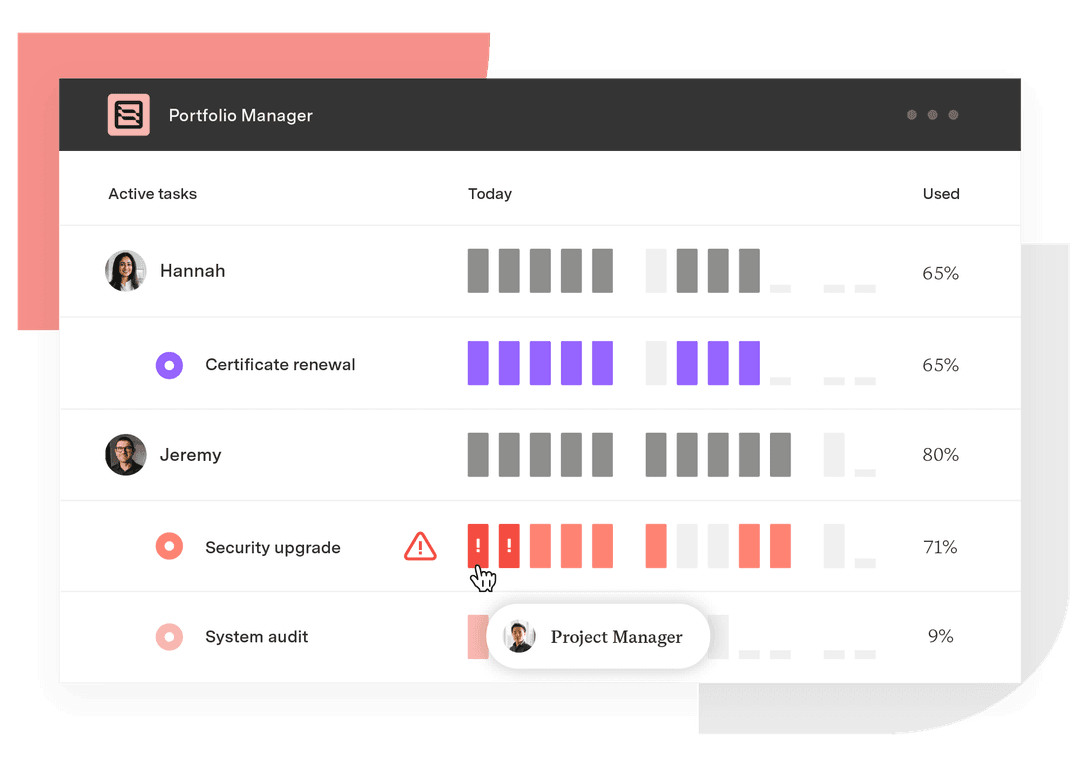IT project management: Phases, challenges, and best practices
Tempo Team
Every IT project starts with a solid plan – but planning isn’t usually where the challenge lies. It’s execution.
Between balancing resources, meeting deadlines, and aligning teams, managing an IT project requires more than a well-documented strategy. Without the right approach, projects can run into delays or suffer from scope creep.
Success comes from anticipating common challenges and leveraging best practices to keep everything on track. Here’s how to do that.
What is IT project management?
IT project management is the structured process of planning, executing, and overseeing projects to ensure they meet objectives.
Whether you’re developing software or rolling out a new system, strong project management involves:
Structuring the project into clear phases: Organize every step in the project lifecycle, from initiation to execution, to avoid confusion and delays.
Managing resources efficiently: Balance workloads and enhance team productivity through effective resource management and capacity planning.
Anticipating and mitigating risks: Identify and address potential issues early with a risk assessment strategy to prevent costly surprises.
Choosing the right project management approach: Select the right framework, whether it’s an agile methodology, traditional project management, or a hybrid approach, to help teams adapt to changes.
Maintaining clear communication: Promote strong stakeholder communication to keep everyone on the same page and consistently track progress to improve visibility and project efficiency.
What are the phases of an IT project?
Every IT project follows consistent stages to stay on track and deliver successful results. Skipping steps or rushing through them can lead to scope creep (when projects expand beyond their original goals) or misalignment between teams and stakeholders.
Here are the typical IT project phases.
1. Initiation phase
Before work begins, determine a clear reason for the project. This phase focuses on answering: What problem are we solving, and what does success look like?
Key steps include:
Identifying the project’s goals, scope, and deliverables
Assessing goal feasibility, including resource planning and technical requirements
Conducting a risk assessment to identify potential challenges
Aligning with stakeholders to set expectations
2. Planning phase
Once the project is approved, map out how to get from point A to point B. The planning phase enhances team productivity by:
Breaking down tasks, dependencies, and milestones
Allocating resources efficiently
Managing timelines using project scheduling software
Establishing an IT project budget to prevent unexpected costs
Choosing the right project management methodologies (e.g., agile, waterfall, hybrid)
3. Execution phase
This is where the hands-on work begins. Developers, designers, and other team members start building and implementing the project, while project managers focus on:
Managing workloads to balance tasks and ensure strong team utilization
Tracking progress and adjusting plans as needed
Communicating with stakeholders to keep everyone aligned
Mitigating risks in IT projects
4. Monitoring and controlling phase
Projects rarely go as planned, so this phase is about staying flexible and making data-driven adjustments. A proactive approach avoids delays and last-minute issues. Key activities include:
Using project tracking software to measure performance
Adjusting resource allocation as priorities shift
Managing IT project risks before they escalate
Preventing team overload through resource leveling
5. Closure phase
Once the team completes the project, finalize deliverables and review overall performance. This phase includes:
Reviewing project outcomes and lessons learned
Conducting a final risk assessment to ensure long-term stability
Implementing change management in IT projects for a seamless transition to new systems or processes
Documenting key insights for future improvements
Common IT project management challenges and solutions
Without strong IT governance, projects stray from the company’s goals, making it harder to allocate resources effectively and manage risks.
Explore the most common project management challenges and how to fix them.
No project mandate
Without a clear goal or formal approval, a project quickly loses direction, and teams may have trouble securing resources and support.
Solution: Give every project a solid foundation with a well-documented project charter that outlines objectives, scope, and deliverables. This aligns stakeholders and provides the support to move the project forward.
Unclear expectations
Ever worked on a project where no one really knows what "done" looks like? This happens when expectations are unclear. In fact, 37% of project failures occur because of poorly defined goals. If responsibilities or success metrics are vague, teams waste time on work that might not even matter.
Solution: Set clear goals from the start. Define key performance indicators, create a roadmap, and regularly check in to ensure everyone is on the same page. Resource planning is also key, as teams need to know their responsibilities and whether they have the tools to meet them.
Poor communication
If teams aren’t aligned, minor misunderstandings become major problems. For example, team members may unknowingly duplicate tasks, leading to wasted time and effort, while important deadlines may slip due to confusion or lack of clear communication.
Solution: Establish a structured communication plan. Regular check-ins and an open feedback loop keep everyone informed and working together. Effective communication ensures projects move smoothly and reduces last-minute surprises.
Scope creep
Scope creep often starts with one small change after another. Before you know it, these minor adjustments have led the project to expand beyond its original plan, leading to increased costs, missed deadlines, and other consequences.
Solution: Set firm boundaries from day one. Every change request should go through a formal approval process, with prioritization based on business impact. This approach ensures the team adjusts the project only when needed, keeping it on track and within budget.
Best practices for IT project managers
Without the right approach, scope creep and misaligned priorities turn even the most well-planned project into a headache. The key is to create structured workflows, stay flexible, and address risks before they become major problems.
Standardize processes for efficiency
A well-structured process keeps projects on track. When teams understand how resource planning, workload management, and capacity planning fit into the bigger picture, they work more effectively.
Those with a Project Management Professional (PMP) certification bring proven strategies to streamline workflows and reduce inefficiencies. By establishing clear processes and automating repetitive tasks, teams focus on high-impact work that boosts profitability.
Prioritize iterative development
No matter how solid the plan, unexpected challenges will arise. Following an agile methodology allows teams to adjust, refine, and improve as they go. Regular check-ins strengthen stakeholder communication, while forecasting project needs prevents last-minute resource shortages. This approach also reduces risks by catching small issues before they become big problems.
Test system integration early
Running system integration tests early in the software development lifecycle avoids last-minute surprises and costly fixes. A proactive focus on risk assessment and mitigation enables teams to address problems before they disrupt the entire project.
IT project management tools and software
The right project management software streamlines workflows by organizing tasks, improving collaboration, and tracking risks. Here are some common options.
Jira project management
Jira is a go-to agile project management tool that allows teams to break projects into manageable tasks and quickly adapt to changes. Designed for Scrum masters and project managers, Jira simplifies workflow management and enables teams to track potential risks before they cause disruptions.
Microsoft Project for scheduling and budgeting
Microsoft Project helps project managers anticipate needs and avoid budget overruns in IT projects. With Gantt charts and resource forecasting features, they stay in control from start to finish.
Trello for task and workflow management
Trello is a great team collaboration tool for those looking for a simple, visual way to stay organized. Its Kanban-style boards make task tracking effortless, supporting project workflow automation and enhancing overall team coordination. Trello highlights priorities to keep teams focused, streamlining everything from software development projects to large-scale enterprise project management initiatives.
Improve IT Project Management with Tempo
Managing an IT project requires strategic decisions to drive success. Without a clear roadmap, projects lose focus, and resource allocation becomes unpredictable.
Tempo Strategic Roadmaps transforms project planning into a dynamic, visual strategy. Spot dependencies, assess risks, and make informed decisions – all within Jira. With better project visibility, you streamline resource planning and keep your project moving forward without costly detours.
Success starts with a plan, but the right roadmap makes that plan a reality. Take control of your IT project management with Tempo Strategic Roadmaps. Book a demo today.












































